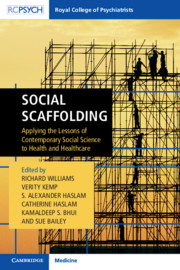Book contents
- Social Scaffolding
- Social Scaffolding
- Copyright page
- Contents
- Contributors
- Foreword
- Note
- Section 1 Schooling
- Section 2 Scoping
- Chapter 6 The Social Determinants of Mental Health
- Chapter 7 Laidback Science: Messages from Horizontal Epidemiology
- Chapter 8 Parity of Esteem for Mental Health
- Chapter 9 Belonging
- Chapter 10 Families and Communities: Their Meanings and Roles Across Ethnic Cultures
- Chapter 11 The Nature of Resilience: Coping with Adversity
- Chapter 12 The Value of Tolerance and the Tolerability of Competing Values
- Chapter 13 Towards Partnerships in Health and Social Care: A Coloquium of Approaches to Connectedness
- Chapter 14 Commentaries on Core Themes in Section 2
- Section 3 Sourcing
- Section 4 Scaffolding
- Section 5 Sustaining
- Index
- References
Chapter 7 - Laidback Science: Messages from Horizontal Epidemiology
from Section 2 - Scoping
Published online by Cambridge University Press: 14 June 2019
- Social Scaffolding
- Social Scaffolding
- Copyright page
- Contents
- Contributors
- Foreword
- Note
- Section 1 Schooling
- Section 2 Scoping
- Chapter 6 The Social Determinants of Mental Health
- Chapter 7 Laidback Science: Messages from Horizontal Epidemiology
- Chapter 8 Parity of Esteem for Mental Health
- Chapter 9 Belonging
- Chapter 10 Families and Communities: Their Meanings and Roles Across Ethnic Cultures
- Chapter 11 The Nature of Resilience: Coping with Adversity
- Chapter 12 The Value of Tolerance and the Tolerability of Competing Values
- Chapter 13 Towards Partnerships in Health and Social Care: A Coloquium of Approaches to Connectedness
- Chapter 14 Commentaries on Core Themes in Section 2
- Section 3 Sourcing
- Section 4 Scaffolding
- Section 5 Sustaining
- Index
- References
Summary
In the last two decades or so, mental health epidemiology has taught us two important messages. The first is that the personal and social burden of mental health conditions, long underestimated, is significantly higher than prevalent physical health conditions such as cancer or diabetes (Olesen and Leonardi, 2003; Andlin-Sobocki & Rehm, 2005).
Second, the cause of this burden is not mortality, or even morbidity, but disability, and, in particular, a wide range of psychosocial difficulties that shape the lived experience of persons who have these disorders and which profoundly affect their quality of life (WHO, 2006; Murray, et al., 2012). Psychosocial difficulties range from problems with attention and memory, emotional lability and listlessness, to disrupted sleep patterns, problems in managing daily routines and interacting with significant others and difficulties at work.
- Type
- Chapter
- Information
- Social ScaffoldingApplying the Lessons of Contemporary Social Science to Health and Healthcare, pp. 58 - 65Publisher: Cambridge University PressPrint publication year: 2019



